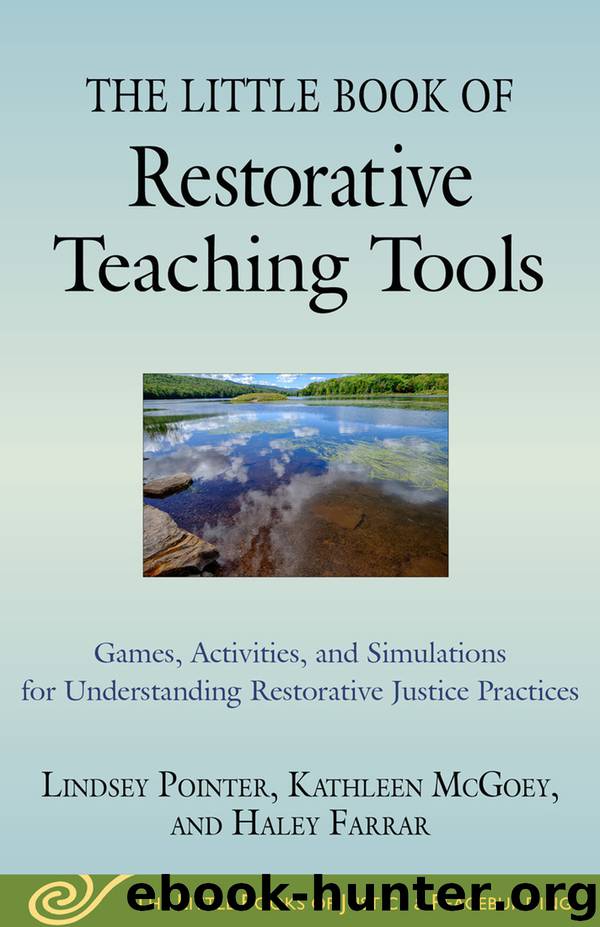The Little Book of Restorative Teaching Tools by Lindsey Pointer

Author:Lindsey Pointer
Language: eng
Format: epub
ISBN: 9781680995893
Publisher: Good Books
Published: 2020-02-19T16:00:00+00:00
6.
How to Design an Experiential Activity for Teaching Restorative Practices
As I coach new volunteers through their first several experiences facilitating community restorative justice processes, the most common feedback I offer is to use more reflective statements and to practice reframing inflammatory or unhelpful statements. My coworkers and I agree that reflecting and reframing are two of the most essential skills needed by facilitators to take on more high-stakes cases and effectively manage the “difficultator” (our term of endearment for that person most likely to throw a curveball severe enough that it could make the whole restorative justice process go sideways).
Reflection and reframing require a facilitator to think on their feet, sometimes in a moment when they may feel uncomfortable, uncertain, or escalated. Knowing we could use an experiential activity to address this need, we created “Mirror Mirror” and “Race to Reframe.” These games provide a low-pressure way to practice these important skills. While “Mirror Mirror” can be used early during a class to generate connection while practicing reflective statements, “Race to Reframe” works well at the end of a class because it adds an element of time pressure and gets people laughing and competing. After several deliveries of “Race to Reframe,” we recognized it was necessary to increase the offensiveness of the statements needing to be reframed, in order to push the skill development of our advanced facilitators. We continue to revisit and adapt both games according to the context and skill level of the group in order to keep them fun and challenging.
—Kathleen McGoey
This chapter describes six steps for designing games and experiential activities for teaching restorative practices, including how to write scenarios and lead an effective debrief of the game or activity to deepen learning. These aspects of design and delivery are intended to help learners to understand the connection between the “micro” learning experience and the larger “macro” issues, concepts, or skills being taught.
Designing an Activity Step 1: Cultivate Self-Reflection and Willingness to Learn
The first step in the process of designing a restorative experiential learning activity is taking the time to reflect on your own relationship to and understanding of a topic. This will include identifying and considering your relevant history, assumptions, and biases. In order to be an effective teacher, you must be willing to learn through the teaching process.
Download
This site does not store any files on its server. We only index and link to content provided by other sites. Please contact the content providers to delete copyright contents if any and email us, we'll remove relevant links or contents immediately.
Bullshit Jobs by David Graeber(4140)
Radical Candor by Kim Scott(2691)
I Am Right, You Are Wrong by Edward De Bono(2428)
23:27 by H. L. Roberts(2223)
Nomadland by Jessica Bruder(2037)
Average Is Over by Tyler Cowen(1824)
The Conflict Resolution Phrase Book by Barbara Mitchell & Cornelia Gamlem(1753)
Out of Our Minds: Learning to Be Creative by Ken Robinson(1720)
High-Impact Interview Questions by Victoria A. Hoevemeyer(1672)
Who Moved My Cheese?: An Amazing Way to Deal With Change in Your Work and in Your Life by Johnson Spencer(1626)
The Ideal Team Player by Patrick M. Lencioni(1621)
An Everyone Culture: Becoming a Deliberately Developmental Organization by Robert Kegan & Lisa Laskow Lahey(1619)
The Asshole Survival Guide by Robert I. Sutton(1579)
Automatic Society by Bernard Stiegler(1532)
Unleashed by Anne Morriss & Frances Frei(1515)
Who by Street Randy & Smart Geoff(1486)
42 Rules of Employee Engagement by Susan Stamm(1451)
96 Great Interview Questions to Ask Before You Hire by Paul Falcone(1435)
Fish! by Stephen C. Lundin(1375)
